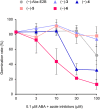Abscinazole-E3M, a practical inhibitor of abscisic acid 8'-hydroxylase for improving drought tolerance
- PMID: 27841331
- PMCID: PMC5107945
- DOI: 10.1038/srep37060
Abscinazole-E3M, a practical inhibitor of abscisic acid 8'-hydroxylase for improving drought tolerance
Abstract
Abscisic acid (ABA) is an essential phytohormone that regulates plant water use and drought tolerance. However, agricultural applications of ABA have been limited because of its rapid inactivation in plants, which involves hydroxylation of ABA by ABA 8'-hydroxylase (CYP707A). We previously developed a selective inhibitor of CYP707A, (-)-Abz-E2B, by structurally modifying S-uniconazole, which functions as an inhibitor of CYP707A and as a gibberellin biosynthetic enzyme. However, its synthetic yield is too low for practical applications. Therefore, we designed novel CYP707A inhibitors, Abz-T compounds, that have simpler structures in which the 1,2,3-triazolyl ring of (-)-Abz-E2B has been replaced with a triple bond. They were successfully synthesised in shorter steps, resulting in greater yields than that of (-)-Abz-E2B. In the enzymatic assays, one of the Abz-T compounds, (-)-Abz-E3M, acted as a strong and selective inhibitor of CYP707A, similar to (-)-Abz-E2B. Analysis of the biological effects in Arabidopsis revealed that (-)-Abz-E3M enhanced ABA's effects more than (-)-Abz-E2B in seed germination and in the expression of ABA-responsive genes. Treatment with (-)-Abz-E3M induced stomatal closure and improved drought tolerance in Arabidopsis. Furthermore, (-)-Abz-E3M also increased the ABA response in rice and maize. Thus, (-)-Abz-E3M is a more practical and effective inhibitor of CYP707A than (-)-Abz-E2B.
Figures







Similar articles
-
Abscinazole-E2B, a practical and selective inhibitor of ABA 8'-hydroxylase CYP707A.Bioorg Med Chem. 2012 May 15;20(10):3162-72. doi: 10.1016/j.bmc.2012.03.068. Epub 2012 Apr 5. Bioorg Med Chem. 2012. PMID: 22525496
-
Abscinazole-E1, a novel chemical tool for exploring the role of ABA 8'-hydroxylase CYP707A.Bioorg Med Chem. 2011 Jan 1;19(1):406-13. doi: 10.1016/j.bmc.2010.11.011. Epub 2010 Nov 10. Bioorg Med Chem. 2011. PMID: 21115253
-
Abscinazole-F1, a conformationally restricted analogue of the plant growth retardant uniconazole and an inhibitor of ABA 8'-hydroxylase CYP707A with no growth-retardant effect.Bioorg Med Chem. 2009 Sep 15;17(18):6620-30. doi: 10.1016/j.bmc.2009.07.070. Epub 2009 Aug 3. Bioorg Med Chem. 2009. PMID: 19699646
-
Development of specific inhibitors of CYP707A, a key enzyme in the catabolism of abscisic acid.Curr Med Chem. 2010;17(28):3230-44. doi: 10.2174/092986710792231987. Curr Med Chem. 2010. PMID: 20666721 Review.
-
The Evolution of the Conceptually Systematic Dimension and Its Current Functions in Applied Behavior Analysis.Perspect Behav Sci. 2024 Feb 1;47(1):1-27. doi: 10.1007/s40614-024-00396-3. eCollection 2024 Mar. Perspect Behav Sci. 2024. PMID: 38660509 Free PMC article. Review.
Cited by
-
Identification of Novel Inhibitors of a Plant Group A Protein Phosphatase Type 2C Using a Combined In Silico and Biochemical Approach.Front Plant Sci. 2020 Sep 16;11:526460. doi: 10.3389/fpls.2020.526460. eCollection 2020. Front Plant Sci. 2020. PMID: 33042170 Free PMC article.
-
QTL Mapping and Candidate Gene Analysis for Pod Shattering Tolerance in Soybean (Glycine max).Plants (Basel). 2020 Sep 8;9(9):1163. doi: 10.3390/plants9091163. Plants (Basel). 2020. PMID: 32911865 Free PMC article.
-
Tandem mass tag-based (TMT) quantitative proteomics analysis reveals the response of fine roots to drought stress in cotton (Gossypium hirsutum L.).BMC Plant Biol. 2020 Jul 11;20(1):328. doi: 10.1186/s12870-020-02531-z. BMC Plant Biol. 2020. PMID: 32652934 Free PMC article.
-
BolTLP1, a Thaumatin-like Protein Gene, Confers Tolerance to Salt and Drought Stresses in Broccoli (Brassica oleracea L. var. Italica).Int J Mol Sci. 2021 Oct 15;22(20):11132. doi: 10.3390/ijms222011132. Int J Mol Sci. 2021. PMID: 34681789 Free PMC article.
-
The AP2/ERF GmERF113 Positively Regulates the Drought Response by Activating GmPR10-1 in Soybean.Int J Mol Sci. 2022 Jul 24;23(15):8159. doi: 10.3390/ijms23158159. Int J Mol Sci. 2022. PMID: 35897735 Free PMC article.
References
-
- Farooq M., Wahid A., Kobayashi N., Fujita D. & Basra S. M. A. Plant drought stress: effects, mechanisms and management. Agron. Sustain. Dev. 29, 185–212 (2009).
-
- Cutler S. R., Rodriguez P. L., Finkelstein R. R. & Abrams S. R. Abscisic acid: emergence of a core signaling network. Annu. Rev. Plant Biol. 61, 651–679 (2010). - PubMed
Publication types
MeSH terms
Substances
LinkOut - more resources
Full Text Sources
Other Literature Sources

